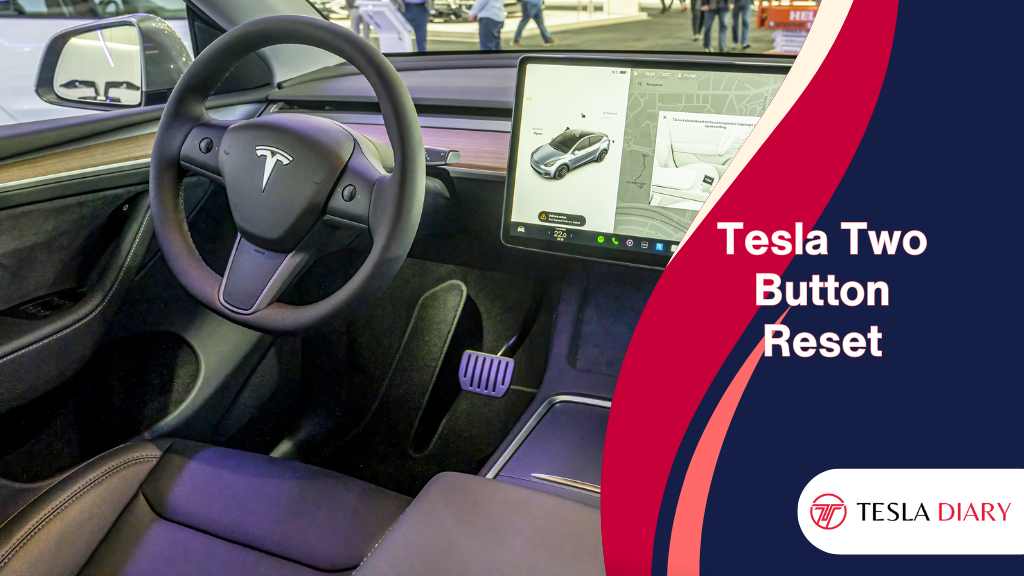In the world of electric vehicles, Tesla stands as a pioneer and leader, known for its cutting-edge technology and innovative features.
However, like any complex piece of machinery, Tesla cars can occasionally experience issues or glitches.
When faced with such situations, Tesla owners can often resolve them using a simple and powerful tool: the Tesla Two Button Reset.
In this article, we will walk you through the process of performing a Tesla Two Button Reset, explain when and why you might need it, and offer some troubleshooting tips for common Tesla problems.

What Is a Tesla Two-Button Reset?
A Tesla Two Button Reset is a soft reset that allows you to restart the car’s computer system and various subsystems, similar to rebooting your computer or smartphone when it’s acting up.
It involves simultaneously pressing and holding two buttons on the car’s steering wheel until the Tesla emblem appears on the center touchscreen.
This procedure is useful for resolving minor issues and can often save you a trip to the Tesla Service Center.
It’s a quick and straightforward process that any Tesla owner can perform, and it can help restore your car to optimal functionality.
When Should You Perform a Tesla Two Button Reset?
Before diving into the step-by-step guide on how to perform a Tesla Two Button Reset, it’s essential to know when you should consider using this reset method. Here are some common situations where a reset can be beneficial:
1. Unresponsive Touchscreen
If your Tesla’s touchscreen becomes unresponsive or freezes, preventing you from accessing important functions like climate control, navigation, or media, a Two Button Reset can often resolve the issue.
2. Software Glitches
Occasionally, Tesla software updates can introduce minor bugs or glitches that impact performance.
Performing a reset after a software update can help eliminate these issues.
3. Connectivity Problems
If you’re experiencing connectivity problems with your Tesla app or Tesla infotainment system, a reset can help reestablish the connection with the Tesla servers and your mobile device.
4. Inoperative Controls
When certain controls, such as the power windows or door locks, stop working as expected, a Tesla Two Button Reset can help restore their functionality.
5. Warning Lights and Error Messages
If you encounter warning lights on your Tesla’s instrument cluster or receive error messages on the touchscreen, a reset may clear these notifications.
However, it’s crucial to investigate the underlying issue if the warnings persist.
Performing a Tesla Two Button Reset: Step-by-Step Guide
Now that you know when a Tesla Two Button Reset is useful, let’s walk through the process step by step. Please follow these instructions carefully:
Step 1: Safely Park Your Tesla
Ensure your Tesla is in a safe location, with the parking brake engaged, and the car is stationary.
The Two Button Reset should not be performed while driving unless necessary.
Step 2: Locate the Reset Buttons
On your Tesla’s steering wheel, you’ll find two buttons: the scroll wheel (located on the right spoke of the steering wheel) and the brake pedal (located at the base of the steering column).
Step 3: Simultaneously Press and Hold the Buttons
Press and hold both the scroll wheels and the brake pedal simultaneously for about ten seconds.
You should continue to hold them down even if the touchscreen goes black.
Step 4: Observe the Tesla Emblem
After holding down the buttons for approximately ten seconds, you will notice the Tesla emblem appearing on the center touchscreen.
This signifies that the reset process has been initiated.
Step 5: Release the Buttons
Once you see the Tesla emblem on the touchscreen, you can release both the scroll wheel and the brake pedal.
Your Tesla will now begin the reset process, which should take about 30 seconds.
Step 6: Wait for the Reset to Complete
During the reset process, you may see the touchscreen flicker, and the car’s systems will restart.
This is normal. Wait for the Tesla emblem to disappear, indicating that the reset is complete.
Step 7: Test the Functions
After the reset is complete, test the functions and features that were previously experiencing issues.
Verify if the problem has been resolved.
Troubleshooting Tips
Performing a Tesla Two Button Reset is a straightforward process, but what if the problem persists even after the reset? Here are some additional troubleshooting tips:
1. Check for Software Updates
Make sure your Tesla is running the latest software version. Tesla frequently releases over-the-air updates to address known issues and improve performance.
Navigate to the “Software” section in your touchscreen’s settings to check for updates.
2. Reboot the Touchscreen
If the touchscreen remains unresponsive after a reset, you can try rebooting the entire car separately.
To do this-
- Go to Controls > Safety & Security > Power Off
- Wait for about 5 minutes.
- Turn the car back on.
3. Contact Tesla Support
If the problem persists despite performing a Two Button Reset and checking for software updates, it’s a good idea to contact Tesla’s customer support or visit a Tesla Service Center for further assistance. They can diagnose and address more complex issues.
Conclusion
The Tesla Two Button Reset is a valuable tool in your arsenal for troubleshooting minor issues with your Tesla vehicle.
With this simple process, you can often resolve problems like unresponsive touchscreens, software glitches, connectivity issues, and more.
However, it’s essential to know when to use it and to explore other troubleshooting options if the problem persists.
Remember that while a Two Button Reset can address many minor issues, it may not resolve more complex problems or mechanical issues.
In such cases, it’s best to contact Tesla support or visit a Tesla Service Center for professional assistance.

